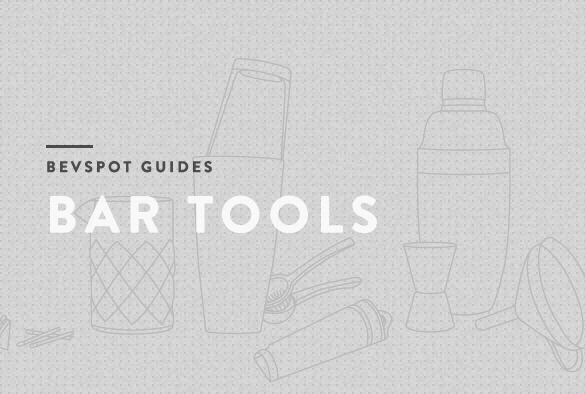


Bartenders need to open beer bottles, strain craft cocktails, create beautiful garnishes, clean up spills, crush ice, measure ingredients and expertly mix up drinks (just to name a few bar manager duties). To get these tasks done efficiently, they need a solid arsenal of tools found here in our bar tools guide.
Also known as a bar strainer, a cocktail strainer is used to remove solid materials from the liquid. It’s typically used after a drink has been stirred or shaken to remove fruit, ice, or other solid materials that the bartender doesn’t want in the final cocktail. There are two basic types of cocktail strainers:
This bar tool is composed of a disc, a handle, two (or more) stabilizing prongs, and a metal spring. This metal bar accessory is used to remove ice and other solid ingredients (such as muddled fruit) from a cocktail as you pour it into a glass. When in use, the metal spring will fit inside the mixing tin, helping to filter out ice and other solid ingredients so the rim of the strainer doesn’t need to touch the rim of the mixing tin.
The Julep Strainer consists of a perforated bowl-shaped cup with a handle. This tool was originally used to serve Mint Juleps before the drinking straw became popular. The bartender would serve the Julep with the strainer placed over it so the drinker wouldn’t get a face full of ice and mint. Now, this strainer is used for making cocktails. It generally fits into a pint glass better than a Hawthorne Strainer so it’s best used when you’re straining from a pint glass.
This bar tool is composed of a disc, a handle, two (or more) stabilizing prongs, and a metal spring. This metal bar accessory is used to remove ice and other solid ingredients (such as muddled fruit) from a cocktail as you pour it into a glass. When in use, the metal spring will fit inside the mixing tin, helping to filter out ice and other solid ingredients so the rim of the strainer doesn’t need to touch the rim of the mixing tin.
Also called a stirring spoon, this specialized spoon was originally designed to (you guessed it) stir cocktails. Bartenders also use it to measure, layer, and sometimes muddle cocktail ingredients. Because it’s made with stainless steel, it’s durable and easy to clean. Plus, it won’t affect the flavor of your customer’s drinks like other spoons might. In an interview with the bar manager at No. 9 Park, Ryan Lotz, he told us that his bar spoon is his top tool. He explains, “A long thin spoon moves much more easily in a glass so it produces a smoother cocktail than something that is jostling around and moving the ice.” There are three types of bar spoons:
This type of bar spoon has a simple design, a twisted handle and a red plastic cap placed on the end. It’s usually easy to find and it’s functional and cheap.
This spoon is sturdier and has a bit more style. Usually, a hammer or disk is attached to the end of the handle that bartenders use to muddle or layer ingredients.
This bar spoon is slimmer and more elongated. The end of the handle has a variety of designs including a fork for grabbing garnishes like olives or a pretty teardrop design.
A cocktail shaker is used to chill and mix drink ingredients. Shaking a cocktail is a great way to thoroughly integrate all of a drink’s ingredients in order to create one blend of flavor. The majority of cocktail recipes call for this tool. There are three basic cocktail shakers:
Also known as the three-piece shaker, this tool includes a large metal shaking tin, a snuggly fit lid, and a small cap to cover the strainer. This strainer is integrated but it can be a bit slower to use, the lid can sometimes get stuck, and there are more parts to clean.
This cocktail shaker is a two-piece tool. It’s composed of one larger mixing glass and one smaller one. Usually the larger mixing glass is tin and the smaller mixing glass is a standard pint glass. When using this tool to shake a drink, it’s essential to make a watertight seal (or you’ll be wearing the cocktail). Also be careful when separating the two parts because the pint glass is fragile. This shaker is quick to use and easy to clean but requires a bit more skill than the Cobbler Shaker. Because it doesn’t have an integrated strainer, you’ll need to use a separate cocktail strainer.
This past fall, we interviewed two of our customers, Paulo Pereira, the beverage director at Boston’s Brass Union, and Sean Earley, a bartender at Ward 8. When we asked them what their must-have bar tool was, Paulo and Sean immediately answered “a Boston Shaker.”
Also known as the Parisian Shaker, this bar tool is a simplified version of the Cobbler Shaker. Although it’s recently become more popular, this shaker is actually quite old. It’s very similar to the Cobbler Shaker but it’s only two pieces and it doesn’t have a built in strainer. It’s also a bit more stylish than the other shaker options. Theses strainers are more difficult to find and tend to be more pricey.
The jigger is a two-sided tool used for liquor measurement. The standard jigger comes in two sizes—one ounce and ½ ounce, or 1 ½ ounce and ¾ ounce. Some jiggers also include extra markings, allowing you to measure quantities like ¾, ⅓, ¼, and ½ of an ounce. When cocktails need exact measurements, the jigger is your go-to tool.
Also known as a bar blade, church key, flat, popper, or mamba, the speed opener is used to quickly and easily remove bottle caps from beer bottles. Because it’s double cut, you can open bottles in the upwards or downwards motion. It’s also flat, making it easy to store it in your pocket. Flair bartenders often use these openers to entertain their customers by using certain techniques to create a loud popping noise or a visual show.
The wine key is essentially three tools in one—a knife, a corkscrew, and a bottle opener. The knife is used to cut through the seal on the top of the wine bottle, the corkscrew is used to twist out the wine cork, and the bottle opener is an additional accessory, used to open beer bottles. Many restaurants and bars require their servers to use this type of wine opener. Sommeliers prefer to use this type of wine opener as well.
Often, when we think cocktails, we think liquids. However, bartenders need a tool for cutting and prepping drink garnishes! Whether you’re cutting zests to twist over cocktails, prepping lemon wedges, or slicing apples to place on drink rims, this 3-inch long blade should be your tool of choice.
A garnish is an important component of almost any cocktail. The channel zester is an awesome tool for creating a classic twisted zest and for infusing the drink with the oils from the fruit.
How else would you pick up ice? And don’t say with your hands or with a glass (see why here)! Ice is essential for practically every beverage you create. Make sure you follow health and safety practices and keep one of these bar tools next to your ice bin.
Used to mix up cocktails before pouring them into your customer’s glass, this cut-crystal, beaker-shaped mixing glass with straight sides, a hefty base, and a spout is a great addition to any bar. Not only is it pretty, but it’s also sturdier than a pint glass and it holds a chill longer. Plus, your customers will be able to watch their drink being made.
Many signature cocktails require the mashing of fresh ingredients. A muddler is a classic and simple tool that’s essential behind any bar. They come in different materials such as stainless steel, wood, and plastic. Some have a smooth head and others have a grinder head for maximum flavor extraction.
Named for its shape, this tool features a sharp, stainless steel blade. It’s made for removing fruit and vegetable skins, making it the perfect tool for creating beautiful drink garnishes.
If your drink recipe calls for crushed ice and you’ve only got ice cubes, it’s time to break out an ice bag. Once a staple in 19th-century bars, this heavy grade canvas bag is a classic way to make crushed ice for your customers’ cocktails. You can buy an ice crusher online but the Lewis Bag is easier to operate and absorbs a good amount of the ice’s moisture so the final drink is less watery.
Pour spouts are used for pouring drinks with speed and accuracy, helping you avoid over-pouring, spillage, and wasted time. If you’ve ever tried to pour without one, you’ve likely seriously botched a cocktail and wasted product. Depending on your bar, they might all be shiny metal and rubber, a medley of plastic multi-colored spouts, or a combination of the two. For more pour spout info and a list of the different types, check out our blog post on pour spouts.
If you’re making fresh craft cocktails, you’ll likely want to include some freshly squeezed juice in your recipes. As a bartender, a juicer, also known as a lemon squeezer, citrus squeezer, or Mexican juicer, uses a levered design with a hinged bowl and handles to effortlessly extract fruit juice. It’s also fairly easy to store and clean.
This slotted decorative spoon was made to dissolve sugar into a glass of absinthe. In the ritual involving classic French absinthe, the absinthe spoon is rested on the rim of a glass filled with a “dose” of absinthe. Then, ice water is carefully dripped onto the sugar cube so it will gradually dissolve.
Whether you’re looking to grate chocolate, cinnamon, or orange skins, a spice grater is a great addition to your behind-the-bar arsenal. This tool allows you to quickly and efficiently extract flavor for craft cocktails.
Although they may be tiny, toothpicks are still essential tools for bartenders. They’re a crucial component for certain cocktail garnishes such as the olives in a classic martini. Toothpicks come in a ton of different varieties such as classic wood, bamboo knot, and plastic sword.
If you’re opening up a bottle of wine behind the bar, your job might be a little easier if you have a foil cutter. With a squeeze, a quarter turn, and a lift, this tool quickly and neatly removes foil from wine bottles, making it easier to remove the cork.
Sometimes, older wine corks can be difficult. They may be brittle and dry, making them fragile and difficult to remove. Using a Butler’s Friend corkscrew, also called an Ah So opener, you can carefully slide the prongs between the cork and the neck of the bottle to remove an old cork more easily.
If you serve wine or champagne by the glass, a champagne stopper is essential barware. Once it’s open, you can use this tool to tightly reseal a bottle to retain the freshness, flavor, and fizz.
If you feature any flaming cocktails, matches are a must have. Although a cigarette lighter will work, matches look a bit classier when lighting drinks or garnishes in front of guests. Not only do flaming drinks look awesome but the act of igniting them also enhances their flavor.
Shaped with a wide mouth and a narrow stem, a funnel is used for decanting flavored syrups and spirits into bottles. If you’re trying to keep the bar and yourself from being covered in a sticky mess, make sure you have a funnel around for easy transfers.
Just like a chef works better with the sharpest knife, bartenders can work better, faster and more efficiently with the best tools behind the bar—and that’s just good business. Make sure to have these bar tools handy to cut the time of bartending tasks, more accurately measure your usage, and impress your customers with brilliant presentation and flavor.
Schedule time to chat with one of our product specialist!

